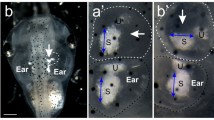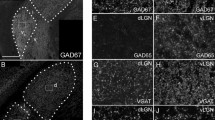Summary
In the frog, Xenopus laevis, a system of intertectal connections underlies the visual projection from an eye to its ipsilateral tectal lobe and is involved in the topographic representation of binocular visual space. Rotation of one eye in early life may be followed by a radical rearrangement of the connections in this system. The modified pattern which later emerges is that which keeps the visual projection through the ipsilateral eye in topographic registration with the direct visual projection from the contralateral eye to the same tectal lobe. This plasticity requires visual experience.
In this paper we describe the time-course and sequence of events by which this plasticity is effected. Following rotation of one eye in larval animals or in animals undergoing metamorphic climax, the earliest evidence of intertectal modification was found 3–4 weeks after metamorphosis. With increasing intervals after metamorphosis an increasing proportion of animals displayed modified intertectal systems. At intermediate intervals many animals showed partial modifications, which were interpreted as transitional stages in the modification process. Analysis of these transitional stages indicated that the sequence of events involved in the elaboration of a modified intertectal system following the experimental alteration of eye alignment exhibits features in common with rearrangements of the system that occur during normal development in response to growth-related alterations in eye alignment.
Similar content being viewed by others
References
Arnett DW (1978) Statistical dependence between neighbouring retinal ganglion cells in goldfish. Exp Brain Res 32: 49–53
Baker FH, Grigg P, Noorden GK von (1974) Effects of visual deprivation and strabismus on the response of neurons in the visual cortex of the monkey, including studies on the striate and prestriate cortex in the normal animal. Brain Res 66: 185–208
Bear MF, Paradiso MA, Schwartz M, Nelson SB, Carnes KM, Daniels JD (1983) Two methods of catecholamine depletion in kitten visual cortex yield different effects on plasticity. Nature 302: 245–247
Bear MF, Singer W (1986) Modulation of visual cortical plasticity by acetylcholine and noradrenaline. Nature 320: 172–176
Bear MF, Kleinschmidt A, Gu Q, Singer W (1990) Disruption of experience-dependent synaptic modifications in striate cortex by infusion of an NMDA receptor antagonist. J Neurosci 10: 909–925
Beazley LD (1975) Development of intertectal neuronal connections in Xenopus: the effects of contralateral transposition of the eye and eye removal. Exp Brain Res 23: 505–518
Beazley LD, Keating MJ, Gaze RM (1972) The appearance, during development, of responses in the optic tectum following visual stimulation of the ipsilateral eye in Xenopus laevis. Vision Res 12: 407–410
Beazley LD, Humphrey MF (1980) The effect of various light conditions on the developmental plasticity of intertectal neuronal connections in Xenopus. J Physiol (Lond) 301:21P
Boss VC, Schmidt JT (1984) Activity and the formation of ocular dominance patches in dually innervated tectum of goldfish. J Neurosci 4: 2891–2905
Chung SH, Bliss, TVP, Keating MJ (1974) The synaptic organization of optic afferents in the amphibian tectum. Proc R Soc Lond [Biol] 187: 421–447
Cook JE (1987) A sharp retinal image increases the topographic precision of the goldfish retinotectal projection during optic nerve regeneration in stroboscopic light. Exp Brain Res 68: 319–328
Cook JE, Rankin ECC (1986) Impaired refinement of the regenerated goldfish retinotectal projection in stroboscopic light: a quantitative WGA-HRP study. Exp Brain Res 63: 421–430
Cook JE, Becker DL (1990) Spontaneous activity as a determinant of axonal connections. Darkness and diurnal light are equally effective for activity-dependent refinement of the regenerating retinotectal projection in goldfish. Eur J Neurosci 2: 162–169
Daw NW, Rader RK, Robertson TW, Ariel M (1983) Effects of 6-hydroxydopamine on visual deprivation in kitten striate cortex. J Neurosci 3: 907–914
Gaze RM, Keating MJ, Szekely G, Beazley LD (1970) Binocular interaction in the formation of specific intertectal neuronal connections. Proc R Soc Lond [Biol] 175: 107–147
Glasser S, Ingle D (1978) The nucleus isthmi as a relay station in the ipsilateral visuotectal projection to the frog's optic tectum. Brain Res 159: 214–218
George SA, Marks W (1974) Optic nerve terminal arborizations in the frog: shape and orientation inferred from electrophysiological measurements. Exp Neurol 42: 467–482
Ginsberg KS, Johnsen JA, Levine MW (1984) Common noise in the firing of neighbouring ganglion cells in the goldfish retina. J Physiol (Lond) 351: 433–450
Grant S, Keating MJ (1986a) Normal maturation involves systematic changes in binocular visual connections in Xenopus laevis. Nature 322: 258–261
Grant S, Keating MJ (1986b) Ocular migration and the metamorphic and postmetamorphic maturation of the retinotectal system in Xenopus laevis: an autoradiographic and morphometric study. J Embryol Exp Morphol 92: 43–69
Grant S, Keating MJ (1989a) Changing patterns of binocular visual connections in the intertectal system during development of the frog, Xenopus laevis. I. Normal maturational changes in response to changing binocular geometry. Exp Brain Res 75: 99–116
Grant S, Keating MJ (1989b) Changing patterns of binocular visual connections in the intertectal system during development of the frog, Xenopus laevis. II. Abnormalities following early visual deprivation. Exp Brain Res 75: 117–132
Gruberg ER, Udin SB (1978) Topographic projections between the nucleus isthmi and the tectum of the frog Rana pipiens. J Comp Neurol 179: 487–500
Gu Q, Bear MF, Singer W (1989) Blockade of NMDA-receptors prevents ocularity changes in kitten visual cortex after reversed monocular deprivation. Develop Brain Res 47: 281–288
Hebb DO (1949) The organization of behaviour. John Wiley and Sons, New York
Hodos W, Dawes EA, Keating MJ (1982) Properties of the receptive fields of frog retinal ganglion cells as revealed by their response to moving stimuli. Neuroscience 7: 1533–1544
Horder TJ, Martin KAC (1977) Variability among laboratories in the occurrence of functional modification in the intertectal visual projection of Xenopus laevis. J Physiol (Lond) 272:90–91P
Hubel DH, Wiesel TN (1965) Binocular interaction in striate cortex of kittens reared with artificial squint. J Neurophysiol 28: 1041–1059
Hubel DH, Wiesel TN, LeVay S (1977) Plasticity of ocular dominance columns in monkey striate cortex. Philos Trans R Soc Lond [Biol] 278: 377–409
Hunt RK, Berman N (1975) Patterning of neuronal locus specificities in retinal ganglion cells after partial extirpation of embryonic eye. J Comp Neurol 162: 43–70
Johnsen JA, Levine MW (1983) Correlation of activity in neighbouring goldfish ganglion cells: relationship between latency and lag. J Physiol (Lond) 345: 439–449
Kasamatsu T, Pettigrew JD (1979) Preservation of binocularity after monocular deprivation in striate cortex of kittens treated with 6-OHDA. J Comp Neurol 185: 139–162
Kasamatsu T, Pettigrew JD, Ary M (1979) Cortical recovery from effects of monocular deprivation: accelaration with norepinephrine and suppression with 6-hydroxydopamine. J Neurophysiol 45: 254–266
Keating MJ (1974) The role of visual function in the patterning of binocular visual connections. Br Med Bull 30: 145–151
Keating MJ (1975) The time-course of experience-dependent synaptic switching of visual connections in Xenopus laevis. Proc R Soc Lond [Biol] 189: 603–610
Keating MJ, Gaze RM (1970a) The depth distribution of visual units in the contralateral optic tectum following regeneration of the optic nerve in the frog. Brain Res 21: 197–206
Keating MJ, Gaze RM (1970b) The ipsilateral retinotectal pathway in the frog. Q J Exp Physiol 55: 284–292
Keating MJ, Beazley LD, Feldman JD, Gaze RM (1975) Binocular interaction and intertectal neuronal connections: dependence upon developmental age. Proc R Soc Lond [Biol] 191: 445–466
Keating MJ, Feldman JD (1975) Visual deprivation and intertectal neuronal connections in Xenopus laevis. Proc R Soc Lond [Biol] 191: 467–474
Keating MJ, Grant S, Dawes EA, Nanchahal K (1986) Visual deprivation and the maturation of the retinotectal projection in Xenopus laevis. J Embryol Exp Morphol 91: 101–115
Keating MJ, Kennard C (1987) Visual experience and the maturation of the ipsilateral visuotectal projection in Xenopus laevis. Neuroscience 21: 519–527
Keating MJ, Grant S (1992) The critical period for experience-dependent plasticity in a system of binocular visual connections in Xenopus laevis: its temporal profile and relation to normal developmental demands. Eur J Neurosci 4: 27–36
Kleinschmidt A, Bear MF, Singer W (1987) Blockade of “NMDA” receptors disrupts experience-dependent plasticity of kitten striate cortex. Science 238: 355–358
Law MI, Constantine-Paton M (1981) Anatomy and physiology of experimentally produced striped tecta. J Neurosci 1: 741–759
Martin KAC (1978) Aspects of the control of the formation of neuronal connections. D.Phil. Thesis, Oxford University
Martin KAC, Ramachandran VS, Rao VM, Whitteridge D (1979) Changes in ocular dominance induced in monocularly deprived lambs by stimulation with rotating gratings. Nature 277: 391–393
McDonald JW, Cline HT, Constantine-Paton M, Maragos WF, Johnston MV, Young AB (1989) Quantitative autoradiographic localization of NMDA, quisqualate and PCP receptors in the frog tectum. Brain Res 482: 155–158
Meyer RL (1982) Tetrodotoxin blocks the formation of ocular dominance columns in goldfish. Science 218: 589–591
Nieuwkoop PD, Faber J (1967) A normal table of Xenopus laevis (Daudin), 2nd edn. North-Holland, Amsterdam
Olson MD, Meyer RL (1991) The effect of TTX-activity blockade and total darkness on the formation of retinotopy in the goldfish retinotectal projection. J Comp Neurol 303: 412–423
Pettigrew JD (1974) The effect of visual experience on the development of stimulus specificity by kitten cortical neurones. J Physiol (Lond) 237: 49–74
Pettigrew JD, Konishi M (1976) Effect of monocular deprivation on binocular neurones in the owl's visual Wulst. Nature 264: 753–754
Reh TA, Constantine-Paton M (1985) Eye-specific segregation requires neural activity in three-eyed Rana pipiens. J Neurosci 5: 1132–1143
Scherer WJ, Udin SB (1989) N-methyl-D-aspartate antagonists prevent interaction of binocular maps in Xenopus tectum. J Neurosci 9: 3837–3843
Schmidt JT, Eisele LE (1985) Stroboscopic illumination and dark-rearing block the sharpening of the regenerated retinotectal map in goldfish. Neurosci 14: 535–546
Udin SB (1983) Abnormal visual input leads to development of abnormal axon trajectories in frogs. Nature 301: 336–338
Udin SB (1989) Development of the nucleus isthmi in Xenopus. II. Branching patterns of contralaterally projecting isthmotectal axons during maturation of binocular maps. Vis Neurosci 2: 153–163
Udin SB, Keating MJ (1981) Plasticity in a central nervous pathway in Xenopus: anatomical changes in the isthmotectal projection after larval eye rotation. J Comp Neurol 203: 575–594
Udin SB, Fisher MD (1985) The development of the nucleus isthmi in Xenopus laevis. I. Cell genesis and the formation of connections with the tectum. J Comp Neurol 232: 25–35
Udin SB, Keating MJ, Dawes EA, Grant S, Deakin JFW (1985) Intertectal neuronal plasticity in Xenopus laevis: persistence despite catecholamine depletion. Develop Brain Res 19: 81–88
Udin SB, Scherer WJ (1990) Restoration of the plasticity of binocular maps by NMDA after the critical period in Xenopus. Science 249: 669–672
Wiesel TN, Hubel DH (1963) Single cell responses in striate cortex of kittens deprived of vision in one eye. J Neurophysiol 26: 1007–1017
Wiesel TN, Hubel DH (1965) Comparison of the effects of unilateral and bilateral eye closure on cortical unit responses in kittens. J Neurophysiol 28: 1029–1040
Author information
Authors and Affiliations
Rights and permissions
About this article
Cite this article
Grant, S., Keating, M.J. Changing patterns of binocular visual connections in the intertectal system during development of the frog, Xenopus laevis . Exp Brain Res 89, 383–396 (1992). https://doi.org/10.1007/BF00228254
Received:
Accepted:
Issue Date:
DOI: https://doi.org/10.1007/BF00228254




